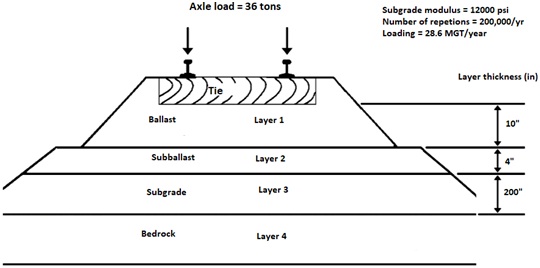Highway & Railway Engineering Individual Project
Project Brief:
You are an engineer working for an engineering consultancy who has been commissioned by a transport authority to provide technical assistance related to the following highway and railway problems:
Part 1: Site Investigations
A detailed deflection survey was carried out using a Falling Weight Deflectometer (FWD) on an existing north-south 2-lane highway pavement. Deflections were recorded at 500 ft intervals in the outer wheel path of both outside lanes.
Analyses of these deflections show relatively high deflections at the point of loading (d1) and large variations over short sections of road. Deflections were initially analyzed for each traffic lane. However, the analyses for the northbound and southbound traffic lanes correlated well so both sets of results were combined by averaging the northbound and southbound deflections. The results are shown in Table Q1.1. Assume sensor 6 is located at a distance of 24in from the load, Poisson's ration of the subgrade is 0.35, and the applied FWD load was 9,000 lb.
1a) Using the method of cumulative-sums technique, identify potential uniform sections for the combined pavement layers and also for the subgrade alone. Clearly show all your workings and present your results (chainage vs. uniform sections) in either a tabular fashion or on a graphical plot.
1b) Estimate the subgrade modulus using Boussinesq's equation and propose treatment option(s) for the subgrade based on the FWD deflection criteria discussed in class.
Table Q1.1 Summary of FWD deflection (mils) data for existing 2-lane highway
|
Chainage
|
Deflection Sensor
|
|
D1
|
D2
|
D3
|
D4
|
D5
|
D6
|
|
0
|
360
|
235
|
148
|
109
|
79
|
52
|
|
500
|
370
|
242
|
192
|
142
|
92
|
39
|
|
1000
|
355
|
200
|
163
|
125
|
88
|
34
|
|
1500
|
335
|
155
|
103
|
83
|
66
|
47
|
|
2000
|
275
|
156
|
141
|
126
|
74
|
34
|
|
2500
|
280
|
158
|
120
|
81
|
43
|
38
|
|
3000
|
300
|
178
|
109
|
79
|
58
|
37
|
|
3500
|
283
|
170
|
120
|
70
|
35
|
25
|
|
4000
|
265
|
172
|
127
|
82
|
37
|
30
|
|
4500
|
263
|
167
|
101
|
74
|
56
|
37
|
|
5000
|
261
|
172
|
166
|
85
|
50
|
25
|
|
5500
|
267
|
170
|
115
|
60
|
45
|
15
|
|
6000
|
263
|
178
|
105
|
71
|
50
|
10
|
|
6500
|
250
|
150
|
113
|
75
|
38
|
12
|
|
7000
|
235
|
160
|
100
|
40
|
39
|
25
|
|
7500
|
223
|
146
|
77
|
49
|
43
|
19
|
|
8000
|
261
|
160
|
105
|
50
|
38
|
28
|
|
8500
|
300
|
185
|
115
|
60
|
48
|
23
|
|
9000
|
400
|
150
|
108
|
53
|
40
|
34
|
|
9500
|
450
|
250
|
148
|
93
|
80
|
35
|
|
10000
|
446
|
315
|
182
|
113
|
68
|
36
|
Part 2: Highway Pavement Analysis and Design
A pavement section has 5 in. (125 mm) of hot mix asphalt, 15 in. (375 mm) of crushed granular base, over a subgrade. Assume the modulus values for the materials are 425, 000 psi (2930 MPa) for the asphalt concrete, 24,000 psi (165 MPa) for the granular base, and 4,500 psi (31 MPa) for the subgrade.
a. Using a suitable elastic layer software (be sure in your write-up to tell me which one), find the critical responses for radial strain in the asphalt concrete, vertical stress in the crushed granular base, and vertical stress in the subgrade, and vertical deflection on the surface. Use a 6 in. tyre radius with a 10,000 lb (44.5 KN) wheel load.
b. Using suitable transfer functions, estimate the pavement life in terms number of equivalent standard axles to limit fatigue and rutting distresses in the pavement section.
Part 3: Track structure analysis & design
a. Describe, with illustrations, four types of trackbed structures in common use indicating some of their advantages and disadvantages
b. For the track structure shown in Figure Q3.1, it desired to replace the concrete ties with wooden ties. Determine the reduction in service life as a result of the change from wooden ties to concrete ties. Clearly state all assumptions made. You may use a suitable any layer elastic analysis software of your choice to support your answer.

Figure 1: Structure for a ballasted trackbed.
Part 4: Environmental impacts
a. Briefly discuss the mechanism of ballast system failure. Use well-labelled sketches to illustrate your answer
b. Discuss the implications of ballast failure.
c. Discuss the main differences between the aggregates for railway ballast and aggregates for highway granular base construction.
d. Discuss three factors that are critical to aggregates used for construction track ballast high speed rail applications.
Are you not capable to handle your academic tasks based on Highway and Railway Engineering? Then without any delay approach our Highway and Railway Engineering Assignment Help service and give rise to your academic success!
Tags: Highway and Railway Engineering Assignment Help, Highway and Railway Engineering Homework Help, Highway and Railway Engineering Coursework, Highway and Railway Engineering Solved Assignments
Attachment:- Highway and Railway Engineering.rar